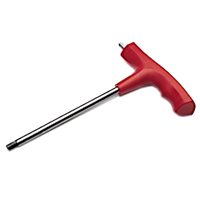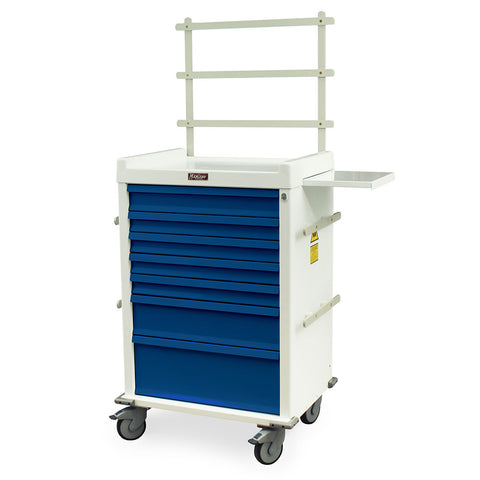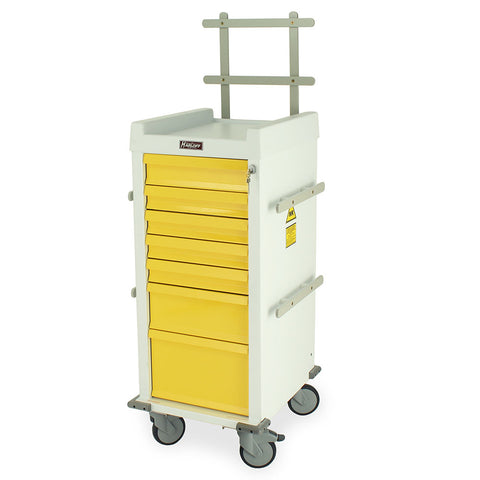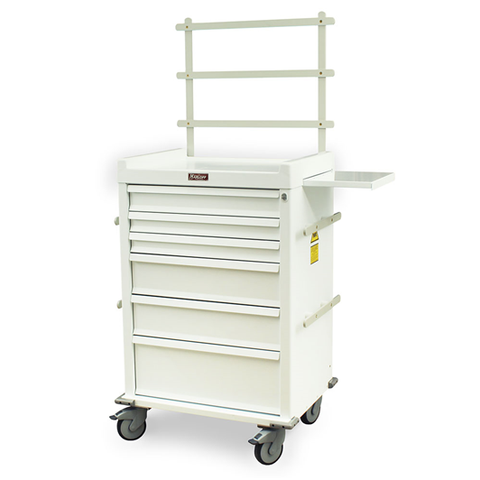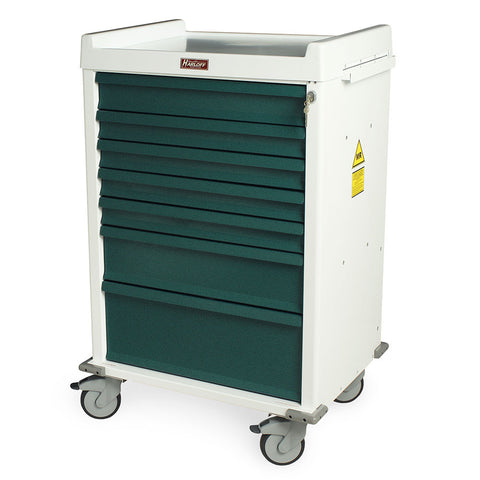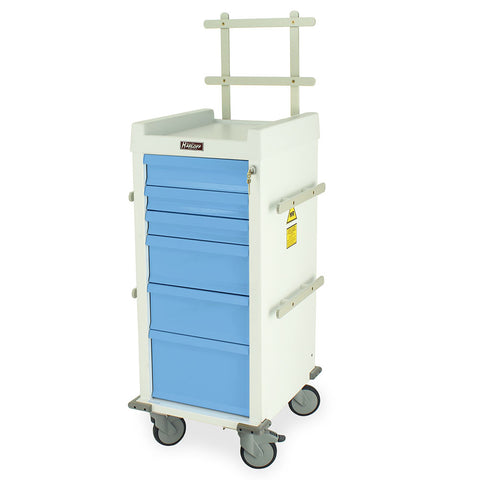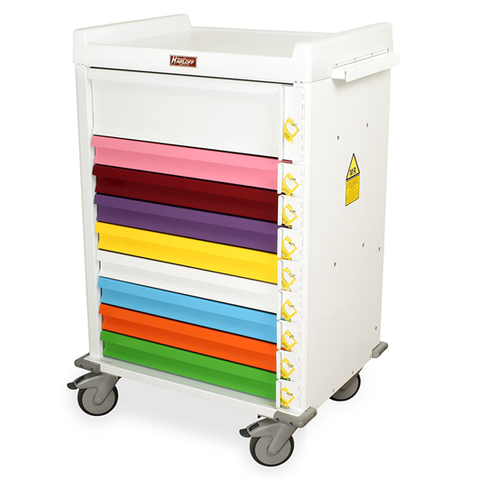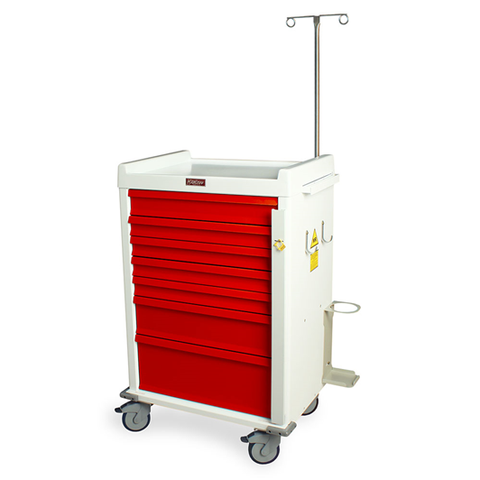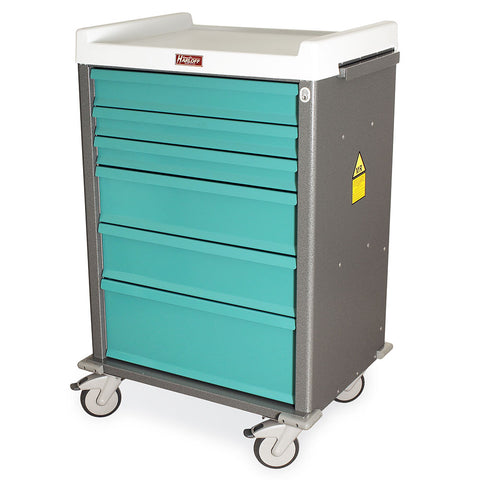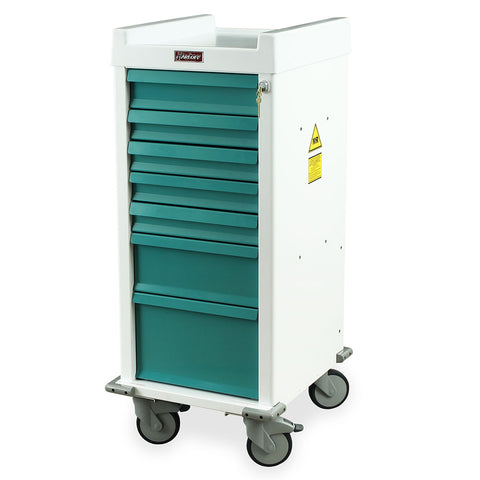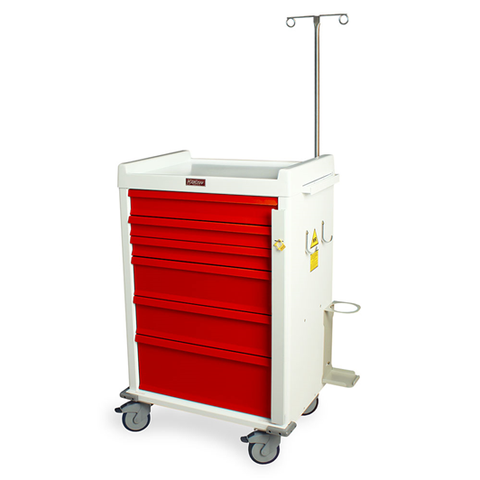Introduction to Non-Magnetic MRI Stretchers
Why MRI Safety Depends on Non-Magnetic Equipment
MRI technology uses extremely strong magnetic fields to create detailed images of the human body. While these fields are essential for accurate diagnostics, they also pose significant safety risks when ferromagnetic materials—like standard hospital stretchers made from steel—are brought near the MRI suite. Ferrous metals can turn into dangerous projectiles, potentially injuring patients and staff.
Non-magnetic MRI stretchers, also called MRI-Conditional stretchers, are specifically designed to eliminate these hazards. They are made of materials such as aluminum, high-density plastics, and other non-ferrous alloys that pose no known hazards in MRI environments. This ensures that patients can be safely transported into and out of the MRI room without compromising safety.
For healthcare facilities, investing in MRI-Conditional stretchers like the MRI Med Adjustable Height Stretcher provides peace of mind, reduces liability, and ensures compliance with international safety standards.
Common Misconceptions About MRI Stretchers
A common misconception is that any stretcher can be used in an MRI suite as long as staff are careful. This is false. Even small ferromagnetic components, such as screws or bolts in standard stretchers, can interact with MRI magnetic fields, leading to injuries or damage to equipment.
Another myth is that all MRI-Conditional stretchers are identical. In reality, these stretchers vary in weight capacity, dimensions, patient comfort features, and maneuverability, depending on the intended clinical use. Products like the MRI Med Non-Ferrous Height Adjustable Stretcher are designed for versatility and durability while remaining fully safe for MRI environments.
Overview of MRI Magnetic Fields and Risks
MRI systems typically operate at magnetic field strengths of 1.5T, 3T, or higher. These fields can attract ferromagnetic objects with extreme force. If a standard stretcher with ferrous components enters the MRI Zone IV area, it can become a projectile, potentially causing serious injuries and damaging expensive equipment.
Non-magnetic MRI stretchers eliminate this risk. By using non-ferrous metals, PVC, and specialty alloys, these stretchers maintain structural integrity without being affected by the MRI magnetic field. For example, the MRI Med Transport Stretcher combines lightweight non-magnetic construction with superior maneuverability, ensuring safe and efficient patient transport.
The Science Behind Non-Magnetic MRI Stretchers
How Magnetic Fields Interact with Ferrous Materials
MRI machines generate strong static magnetic fields, often measured in 1.5 to 3 Tesla, which is thousands of times stronger than the Earth’s magnetic field. Any ferrous (iron-containing) material introduced into this field experiences magnetic attraction, which can create uncontrolled movement. In practical terms, a standard hospital stretcher made of steel or iron could be violently pulled toward the MRI magnet, endangering both the patient and staff.
Non-magnetic MRI stretchers are engineered to avoid this risk entirely. They use non-ferrous metals like aluminum, high-density plastics, and specialty alloys that are unaffected by magnetic fields. For instance, the MRI Med Non-Ferrous Height Adjustable Stretcher maintains structural integrity without posing hazards in MRI environments, ensuring safe patient transport.
Risks of Magnetic Interference and Projectiles
When ferrous objects enter an MRI suite, there are two primary risks. The first is the projectile effect, where objects are pulled toward the magnet at high speed. The second is interference with imaging quality, which can distort scans, leading to diagnostic errors.
MRI-Conditional stretchers like the MRI Med Adjustable Height Stretcher prevent both risks. Their non-magnetic construction ensures that the MRI field does not interact with the stretcher, and scanning artifacts are minimized. By complying with ASTM F2503 labeling, these stretchers provide verified MR Conditional performance, meaning they are safe under defined MRI conditions.
How MRI-Conditional Stretchers Protect Patients and Staff
The design of MRI-Conditional stretchers goes beyond using non-magnetic materials. Engineers consider weight distribution, wheel design, and adjustable features to prevent accidental tipping or patient movement during MRI transport.
For example, the MRI Med Non Ferrous Height Adjustable Stretcher combines non-magnetic construction with smooth-rolling non-ferrous casters, allowing staff to maneuver patients safely and efficiently. The stretcher’s adjustable height function enables seamless transfers from beds or MRI tables without strain, reducing the risk of injury to both patients and personnel.
Using MRI-Conditional stretchers ensures full compliance with MRI safety protocols while maintaining operational efficiency in imaging suites. Hospitals and imaging centers can reduce liability, improve patient outcomes, and maintain high-quality imaging without compromise.
Materials Used in Non-Magnetic MRI Stretchers
Non-Ferrous Metals: Aluminum and Specialty Alloys
One of the primary reasons MRI stretchers are non-magnetic is the use of non-ferrous metals such as aluminum and specialized alloys. Unlike steel, aluminum is completely unaffected by magnetic fields, making it an ideal choice for MRI-Conditional stretchers. It provides the strength and durability needed to safely transport patients while maintaining compliance with MRI safety standards.
For example, the MRI Med Adjustable Height Stretcher uses high-quality aluminum framing to ensure maximum stability. This design provides long-term durability and allows the stretcher to support patients of varying weights without compromising safety in MRI environments.
Specialty alloys are also incorporated in certain stretcher components to enhance load-bearing capabilities without introducing ferromagnetic risk. These alloys are rigorously tested under ASTM F2503 guidelines to verify that they pose no known hazards in MRI conditions.
High-Density Plastics and PVC Components
Beyond metals, MRI stretchers utilize high-density plastics and PVC to further reduce magnetic risk. These materials are lightweight, non-conductive, and resistant to wear and tear, making them ideal for patient surfaces, side rails, and accessory mounts.
The MRI Med Non-Ferrous Height Adjustable Stretcher incorporates PVC patient rails and high-density plastic head and foot panels, which provide both comfort and safety. These materials are MR Conditional, meaning they have been tested to ensure they are safe under specified MRI conditions.
Using plastics in combination with non-ferrous metals allows stretcher manufacturers to optimize strength, durability, and MRI safety simultaneously.
Non-Magnetic Wheels, Casters, and Fasteners
A critical consideration for MRI stretchers is the wheels, casters, and fasteners, which can sometimes contain hidden ferrous materials. Non-magnetic MRI stretchers are equipped with special non-ferrous casters and stainless or aluminum fasteners to prevent any interaction with magnetic fields.
For instance, the MRI Med Transport Stretcher features non-magnetic swivel casters that allow smooth maneuvering even in tight MRI suites. All fasteners are verified for MRI safety, ensuring that no component inadvertently becomes a projectile hazard.
This careful selection of materials guarantees that every part of the stretcher is MRI-safe or MRI-Conditional, protecting patients, staff, and expensive imaging equipment.
Design Features That Make MRI Stretchers Safe
Adjustable Height and Ergonomic Design
MRI-Conditional stretchers are carefully engineered to meet both patient safety and staff ergonomics. Adjustable height is a key feature that allows healthcare professionals to transfer patients safely between beds, gurneys, and MRI tables without straining their backs. The MRI Med Adjustable Height Stretcher offers smooth hydraulic adjustment with non-magnetic controls, allowing staff to raise or lower the stretcher quickly and safely. This not only ensures patient comfort but also improves workflow efficiency in MRI suites.
Side Rails and Patient Safety Features
Side rails are essential for preventing patient falls during transport, particularly in environments where patients may be sedated or have limited mobility. MRI-Conditional stretchers feature non-magnetic, durable side rails that lock securely in place. These rails are tested for structural strength and MRI safety, ensuring that they will not move unexpectedly and pose no risk in the magnetic environment. The design also allows for easy folding or removal when transferring patients onto MRI tables or other equipment.
Wheels, Casters, and Maneuverability
One of the most important design aspects of MRI stretchers is mobility. Non-magnetic casters allow staff to maneuver patients smoothly in tight MRI rooms. For example, the MRI Med Non-Ferrous Height Adjustable Stretcher features 360-degree swivel casters made from non-magnetic materials that ensure quiet, effortless movement. Maneuverability is critical not only for workflow efficiency but also for patient safety. Smooth-rolling wheels reduce jolts and vibrations that could cause discomfort or injuries, while locking mechanisms ensure stability when stationary.
Equip Your Team with Tools They Can Trust
Get high-quality, MRI-dedicated equipment that supports safer scans, better positioning, and smoother patient care.
View Trusted Products
Patient Comfort Features
MRI-Conditional stretchers also focus on patient comfort during scans and transport. Features like padded surfaces, adjustable backrests, and ergonomically designed patient support areas help minimize patient anxiety and discomfort. The MRI Med Adjustable Height Stretcher provides soft, easy-to-clean padding with contours that support proper posture. Adjustable backrests allow patients to be positioned comfortably for imaging, reducing movement and improving scan quality.
Accessories and Attachments
MRI-Conditional stretchers often include attachments and accessories designed to be MRI-safe. This includes IV poles, monitor mounts, and oxygen tank holders made of non-ferrous materials. The MRI Med Stretchers support a variety of MRI-conditional accessories, allowing comprehensive patient care without introducing ferrous hazards. All accessories are tested under ASTM F2503 guidelines, ensuring they are MR Conditional and safe for use under specified MRI conditions.
Testing and Certification of MRI-Conditional Stretchers
How Manufacturers Test Equipment for MRI Environments
Before a stretcher can be labeled MRI-Conditional, it undergoes extensive testing to ensure it is safe under specified MRI conditions. This testing evaluates magnetically induced forces, torque, RF heating, and functional safety.
For example, the MRI Med Adjustable Height Stretcher is tested in controlled MRI environments to verify that all components, including the frame, wheels, and accessories, pose no known hazards. These tests confirm that the stretcher can safely operate without moving unexpectedly, causing burns, or creating interference with imaging.
Testing is performed at various field strengths—commonly 1.5 Tesla and 3 Tesla, which are standard in hospital MRI machines. Every component, from fasteners to hydraulic systems, is evaluated to ensure MR Conditional compliance.
Understanding MRI Field Strength Ratings (1.5T, 3T, and Beyond)
MRI machines operate at different magnetic field strengths, measured in Tesla (T). Common clinical MRI systems are 1.5T or 3T, though some specialized research systems may reach 7T or higher. MRI-Conditional stretchers are certified for specific field strengths. For instance, the MRI Med Non-Ferrous Height Adjustable Stretcher is tested and rated for safe use up to 3T under defined conditions, ensuring no hazards to patients or staff. It is crucial to match the stretcher’s certified rating to the MRI system in your facility to maintain safety and compliance.
Importance of ASTM and FDA Labeling Compliance
ASTM International and the FDA provide clear guidelines for MRI safety labeling. Stretchers that meet ASTM F2503 standards carry MR Conditional labels, which define the exact conditions under which the device is safe. This labeling ensures that hospital staff understand the safe use parameters and reduces the risk of accidents or equipment damage. Compliance with ASTM and FDA guidelines also protects healthcare facilities legally, ensuring they meet regulatory standards and reduce liability risks. Proper documentation and labeling make it easier for imaging departments to integrate MRI-Conditional stretchers safely into daily workflows.
Benefits of Using MRI-Conditional Stretchers
Using MRI-Conditional stretchers like the MRI Med Adjustable Height Stretcher and MRI Med Transport Stretcher delivers multiple benefits:
-
Maximum patient safety during MRI scans and transfers.
-
Clear regulatory compliance and reduced liability risks.
-
Enhanced operational efficiency for imaging departments.
These advantages make MRI-Conditional stretchers an essential investment for any facility with an MRI suite, ensuring safety, reliability, and improved workflow.
How to Identify Genuine MRI-Conditional Stretchers
To identify a genuine MRI-Conditional stretcher, always:
-
Check MR Conditional labels and read the documentation carefully.
-
Be aware of marketing myths and outdated terminology.
-
Purchase from trusted suppliers who provide fully tested, certified products.
Following these steps ensures patient safety, regulatory compliance, and efficient operation within the MRI suite, while protecting staff and equipment.
Choosing the Right MRI-Conditional Stretcher for Your Facility
Choosing the right MRI-Conditional stretcher involves a careful balance of:
-
Weight capacity and patient comfort
-
Compatibility with MRI room workflow and space constraints
-
Long-term value compared to upfront costs
By considering these factors and selecting tested, certified products from trusted suppliers like MRI Med, facilities can ensure safe, efficient, and compliant patient transport within MRI suites.
Frequently Asked Questions
-
Can a standard stretcher ever be used in an MRI room?
Standard hospital stretchers typically contain ferrous metals and magnetic components, making them unsafe in MRI environments. Using a standard stretcher can create a projectile hazard, interfere with imaging, or damage the MRI scanner.
-
What makes an MRI stretcher “MRI-Conditional”?
An MRI-Conditional stretcher is labeled MR Conditional according to ASTM F2503 standards. This means it has been tested in specific MRI conditions and confirmed to be safe for patient use without compromising MRI scan quality. Materials are non-ferrous and non-magnetic, wheels and fasteners are MRI-conditional, and the stretcher has undergone rigorous testing for magnetic displacement, heating, and interference.
-
How do MRI stretchers prevent interference with scans?
MRI-Conditional stretchers prevent interference through careful material selection and design. Non-magnetic metals, specialized plastics, and non-conductive composites reduce the risk of image distortion or artifacts.
-
Are MRI stretchers compatible with all scanner field strengths?
No, MRI-Conditional stretchers are tested for specific magnetic field strengths, often including 1.5T and 3T environments. Each product comes with field strength ratings listed in its documentation.
-
How often should MRI stretchers be maintained or inspected?
Regular maintenance and inspections are critical to ensure continued safety and performance. MRI-Conditional stretchers should undergo routine checks for wheel function, locking mechanisms, padding integrity, and material wear. Products come with maintenance guidelines from the manufacturer, and hospitals should schedule quarterly or semi-annual inspections to prevent potential failures during patient transport.
